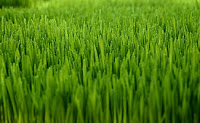I have a question: Do you know what type of grass your playing golf on? Does it even matter? This article HERE seems to suggest it does.
With all the different grasses out there (Bentgrass, Kentucky Bluegrass, Bermuda Grass, Perennial Rye Grass, Poa Annua Grass, etc.), could we actually play better if we figured out what grass the course has before each round? Should they put that on the scorecard along with the slope and course rating? Do pros take the type of grass into consideration?
This is all news to me – perhaps I need to speak with a golf superintendent. Ugh, golf just keeps getting more and more complicated…

Any golfer will tell you that perfecting the putt makes a whole lot of difference in their golf game. However, not every golfer can make it to the practice green on a regular basis, which makes installing an artificial putting green a smart choice. These home putting greens can either be installed indoors or outdoors, and allow golfers to practice their putts anytime of the day.
As a golf superintendent that has managed and played (4 handicap) nearly every type of grass used on golf courses, I can say that turf definitely matters for lower handicap players and less for higher handicaps. This is due to ability and the use of spin to shape and control shots everywhere but the greens. The lower handicap player has better ball contact and faster clubhead speed to combat turfs like bluegrass and bermuda that can be sticky or grab clubheads. On the putting surfaces, turf type matters for the first few holes and by the 3rd or 4th hole if you have not figured out how to putt on Poa, bermuda, or bent, whichever is present on the course…go get a lesson. Most courses are consistent from one green to the next and the turf type likely is not the reason you cannot get the ball in the hole. In general, bents are preferred for more true surfaces, but there are some phenomenal Poa annua and bermuda types that produce great ball roll now.